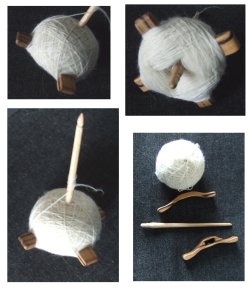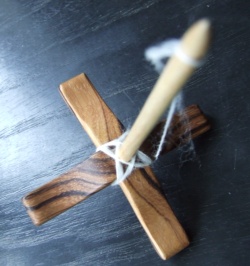
IST Crafts Turkish spindle, courtesy of Cecile
Bottom whorl drop spindles, as their name suggests, differ from the high or top whorl spindles by the fact that the whorl is situated in the lower part of the shaft, giving it a low centre of gravity. The yarn is then secured at the top of the shaft, either through a hook or with a half hitch.
The Turkish spindle is a variant on the bottom whorl spindle. On a Turkish, the whorl is not made of one piece, but of arms. The cop is not wound above the whorl but around it. Unlike other types of spindles, the Turkish spindle is made from independent parts and can be easily disassembled. The whorl consists of two pieces, which slide into each other to form four arms, and the shaft runs through both pieces, stabilising the whole. Mine, shown here, is a tiny beauty weighing just 10 grams, its shaft is ash and its whorl zebrano wood. It’s an IST Crafts creation and spins like a dream. I absolutely love it, and I’ve spun a lot of cobweb singles on it. Like all spindles, the Turkish spindles come in a variety of weights and shapes, so a heavier one will be more suited to thicker yarns.

Turkish spindle with the cop almost at full capacity, courtesy of Cecile
On a Turkish, the cop is built by wrapping the yarn around the arms. Once the spindle is full, which is when the cop almost reaches the ends of the arms, or once you have enough yarn, the cop can be removed by sliding the whorl and cop up and off the shaft, then pushing the arms out, thinnest one first. This presents one major advantage: as the arms are removed, the cop stands as a stable ball of yarn, meaning that it can be used straight away without having to wind it off the spindle, either to ply or to knit. By securing the start of the yarn onto the shaft before starting the cop it is apparently possible to use the ball from both ends. This is not something I’ve done yet, so please let me know if you have.
If you are a Ravelry user, there is a very interesting thread on building a cop on a Turkish spindle, with some beautiful images of cops being built with amazing regularity. I do realise that marveling at this makes me the ultimate spinning geek, but I can live with that. I also have to admit that I am far from being as systematic in my cop building as the Ravelers in question and rather tend to wind my cops any old way, following only the ‘under one arm and over two’ system, which helps keeping the base of the spindle relatively flat, and builds the cop mainly upward and outward. What I love most is the little star shape the yarn makes on the arms at the very start.

Isn't the star shaped cop at the base of the spindle cute?, courtesy of Cecile
Overall I find I spin on the Turkish spindle slightly slower than on some other of my spindles because I’m not as fast winding the cop on the Turkish as I am on my top whorls. And yet, I still use it a lot, because it’s such a joy to spin with. I thoroughly enjoy my teeny tiny Turkish: it’s my lightest and smallest spindle, so a favorite to carry around, and I just love being able to take the cop out, instantly freeing the spindle.
The images in this post are copyright of Cecile from Ways of the Whorl. If you wish to use the images please request permission from Cecile.
I like the drop spindle, that is how I learned to spin. I have a question.
ReplyDeleteis there a way you can get the different weights on these spinners like
finger or worsted weight and how is that done.When I ply I come out
with a heavy weighted yarn, or a dk weight yarn.
thanks blessed576@yahoo.com
Hi Susan,
ReplyDeleteYou can certainly spin any weight of yarn on a drop spindle, the only thing you need to achieve this is practice.
The thickness of your yarn depends entirely on the amount of fiber you draft before you let the twist into it. If you want to obtain a thinner yarn, draft it further before you allow the twist to travel up. With practice you'll be surprised at how thin you can make your single. Remember that your finished yarn will always be a bit thicker than the sum of its singles because air gets trapped into the ply.
Many other factors, such as different weights or types of spindles will also facilitate thinning your singles. Experienced spinners can spin thin singles on heavy drop spindles, but if you're learning, it is much easier to spin thin on a lighter spindle. The Turkish spindle shown here is just about 10 grams for instance, and can spin quite fast, making it fairly easy to spin laceweight 2-ply yarn. A thinner single also needs more twist than a thick one to lock the fibers into place, so you might need to spin the spindle a bit longer for a similar length of singles.
For thicker yarns, heavier spindles prevent the spindle back-spinning too easily. Thicker yarns are also easier to achieve with long-staple fibers.
I hope that answers your question somewhat, but there's no magic shortcut on this, just practice. Most spinners tend to spin at a specific thickness and it will require more concentration and practice to obtain a different one (I tend to go for very very thin and find it quite difficult to spin a 2-ply dk weight evenly).
Spin on and you'll get there. I hope you enjoy your spindling...
I saw one of these the other day and I was wondering exactly what it was. I'm very new to all of this but I'm excited to get started. :)
ReplyDeleteDo you think I would be OK starting with one of these, or should get more practice first?
Hi Maxine,
ReplyDeleteWelcome in the world of spindles, just a word of caution before you get started: this is a highly addictive activity and we decline any responsibility towards any erratic and obsessive behaviours which might develop as a result.
Now, about your question, I don't think there's any problem at all with starting on a Turkish spindle. Many spindlers start on bottom whorl spindles, and the Turkish spindle is just one of those, it requires a bit more attention in winding on, but that's not difficult, just a tiny bit more time consuming. Plus the Turkish does have the advantage of a more stable cop, which doesn't slip as easily if you wind it on too loose, as many people tend to do at the start.
The only thing you'll need to know which you wouldn't for a top whorl is how to do a half hitch, so you can secure the yarn at the top of the shaft (shown here: http://www.youtube.com/watch?v=W1l3tAMFu3c). And it won't take you long to master that. Many Turkish (IST Crafts, but also Jenkins and many, many more) have a little knob at the top of the shaft to secure the half hitch more easily.
Personnally I started on a top whorl only because I could easily get my hands on one. I don't think one type of drop spindle is harder than another to learn on but I think you should try as many different types of spindles as possible any opportunity you get because it is the best way to find what will feel most natural to you. However you should probably start with one heavier than the one featured here, which would be too light for the thickness of singles most spindlers produce when first learning. I would suggest a spindle around 30-40 grams, you will be able to spin a wide range of yarn weights on it with practice.
Let us know how you get on, and don't hesitate to ask if you have any more questions!